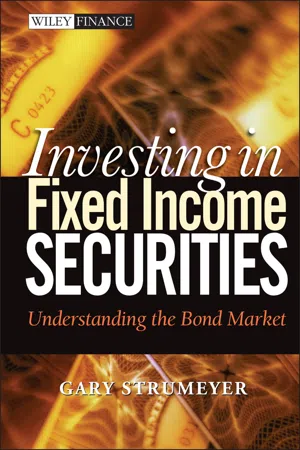Corporate Bonds
Corporate bonds are debt securities issued by corporations to raise capital. Investors who purchase these bonds are essentially lending money to the company in exchange for periodic interest payments and the return of the bond's face value at maturity. Corporate bonds are typically considered to have higher yields than government bonds, but they also carry a higher risk of default.
8 Key excerpts on "Corporate Bonds"
- Thomas Herold(Author)
- 2020(Publication Date)
- THOMAS HEROLD(Publisher)
...What are Corporate Bonds? Corporate Bonds are debt securities that a company issues and sells to investors. Such Corporate Bonds are generally backed by the company’s ability to repay the loan. This money is anticipated to result from successful operations in the future time periods. With some Corporate Bonds, the physical assets of a company can be offered as bond collateral to ease investors’ minds and any concerns about repayment. Corporate Bonds are also known as debt financing. These bonds provide a significant capital source for a great number of businesses. Other sources of capital for the companies include lines of credit, bank loans, and equity issues like stock shares. For a business to be capable of achieving coupon rates that are favorable to them by issuing their debt to members of the public, a corporation will have to provide a series of consistent earnings reports and to show considerable earnings potential. As a general rule, the better a corporation’s quality of credit is believed to be, the simpler it is for them to offer debt at lower rates and float greater amounts of such debt. Such Corporate Bonds are always issued in $1,000 face value blocks. Practically all of them come with a standardized structure for coupon payments. Some Corporate Bonds include what is known as a call provision. These provisions permit the corporation that issues them to recall the bonds early if interest rates change significantly. Every call provision will be specific to the given bond. These types of Corporate Bonds are deemed to be of greater risk than are government issued bonds. Because of this perceived additional risk, the interest rates almost always turn out to be higher with Corporate Bonds. This is true for companies whose credit is rated as among the best. Regarding tax issues of Corporate Bonds, these are pretty straight forward. The majority of Corporate Bonds prove to be taxable, assuming that their terms are for longer than a single year...
- eBook - ePub
A simple approach to bond trading
The introductory guide to bond investments and their portfolio management
- Stefano Calicchio(Author)
- 2020(Publication Date)
- Stefano Calicchio(Publisher)
...Corporate Bonds Corporate Bonds are debt securities generally issued by industries or service companies, organized as corporations and with the aim of raising money at a favourable cost compared to what is already possible on the traditional banking circuit. As we have already seen, subscribers are also looking for a favourable return compared to the rates offered by the market; it is precisely from the interest paid that an investor draws the main motivation for investment with respect to a government bond, certainly more secure, but not as profitable. It is therefore worth pointing out the two major differences between government and Corporate Bonds. Compared to the former, private bonds are considered: - more risky, thus offering a number of advantages to their subscribers; - more illiquid, exposing investors to greater trading difficulties and higher spreads if they wish to liquidate them before maturity. As with government bonds, Corporate Bonds can vary considerably in risk and return, depending on the issuer profile. Private issues considered to be safer are those of banking origin; this is because banks enjoy extensive public protection, generally provided by the State or the Central Bank of the country in which they are issued. Moreover, they are often considered as systemic risk companies (too big to fail), so even in times of market difficulties they can benefit from support measures that are precluded to traditional companies. On the other hand, bank bonds generally have a rather long duration, which on average is not less than 10 years, so they should be considered mostly as long-term investments. Another opportunity to invest in private bonds is offered by large public limited companies, which enjoy a high degree of flexibility in the issuance of debt securities...
- eBook - ePub
Investing in Fixed Income Securities
Understanding the Bond Market
- Gary Strumeyer(Author)
- 2012(Publication Date)
- Wiley(Publisher)
...Chapter 11 Corporate Bonds Michael Bruno, Gary Strumeyer O ver the past number of years we have seen a steady increase in the holdings of Corporate Bonds by retail investors. This phenomenon is more than just an increase in mutual fund purchases. Rather, it is indicative of the individual investor purchasing Corporate Bonds directly from friendly bond brokers. According to the Federal Reserve, the percentage of household assets in corporate and foreign bonds grew 70 percent between 1995 and 1999. It is surprising that U.S. households now hold more corporate and foreign debt than they do municipal bonds, commonly thought of as the retail investor’s safe haven. By purchasing bonds directly, the investor is in fact cutting out the middleman, avoiding the annual management fees charged by funds and money managers alike. However, there is no free lunch. The investor is now charged with understanding and navigating this complex marketplace. Upon completing this chapter the reader will be on his or her way to becoming an educated and successful corporate bond investor. WHAT IS A CORPORATE BOND? Like governments and governmental agencies, corporations of all sizes and types issue public debt. Many corporations take advantage of private issuance and sell certain bond issues directly to large, financially sophisticated organizations such as life insurance companies and pension funds. These transactions are registered with the Securities and Exchange Commission (SEC) differently from the way public bonds are issued and sold. Such issues are regulated under Rule 144A of the SEC. The holder of a corporate bond typically expects the company that issued the bond to make regular interest payments (the coupon) and to repay the principal amount of the loan (the par amount) when the bond matures. Under the terms of the bond offering, the corporation is obligated to make these payments...
- Stefano Calicchio(Author)
- 2014(Publication Date)
- Stefano Calicchio(Publisher)
...Bonds Bonds are an attractive option for investors who want to exploit other financial tools in addition to equity securities, due to the fact that the available range is wide and depends on their risk, duration and performance. Although there are different kind of bonds, we will begin by offering you a general trading definition: they are a debt security under which the issuer owes the owners a debt and, according to the terms of the bond, he is forced to pay him an interest and/or refund him the amount at a later date. We can divide them into different categories according to various types of parameters. For example: • Government Bonds: they are generally quite liquid, although creditworthiness can vary a lot depending on the state or country of issuance; • Corporate Bonds: their interests are characterized by highly variable risk levels depending on the type of business and growth prospects of the issuers; • Different kinds of Government Bonds: in this case the emitters can be a town hall, a province, or a region. There are also other factors that can influence directly and indirectly the prices of debt securities and that investors will have to take into account when they open or manage a position. To simplify, we can quote the following ones: • Interest Rate: They largely determine the performance of bonds and tend to rise when the price drops; • Duration: The interest rate of decennial bonds is higher than annual bonds because the risk is greater; • Issuer Ratings: Although it is difficult to define the absolute value of companies or government agencies that issue a bond, there are many credit rating agencies...
- eBook - ePub
The Everything Guide to Investing in Your 20s & 30s
Your Step-by-Step Guide to: * Understanding Stocks, Bonds, and Mutual Funds * Maximizing Your 401(k) * Setting Realistic Goals * Recognizing the Risks and Rewards of Cryptocurrencies * Minimizing Your Investment Tax Liability
- Joe Duarte(Author)
- 2019(Publication Date)
- Everything(Publisher)
...CHAPTER 7 Bonds: The Glue That Holds Financial Markets Together Talk of bonds is boring at parties, but as an investor you should know that bonds are the glue that holds the markets together. Think of it this way: without bonds, the global economy would be a totally different place, one of much slower growth and fewer prospects. In this chapter you’ll learn why bonds are important and how they make sense for your portfolio. What Is a Bond? A bond is a loan packaged as a marketable security. When investors buy bonds, they are loaning money to a company, a municipality, or a sovereign government with the expectation that the money will be paid back at a predetermined date in the future along with interest. Bonds usually pay interest to the bondholder, either in installments or as one lump sum when the bond matures. Most pay interest semiannually or annually. You can buy bonds directly as new issues from the issuer, or you can buy them through traders, dealers, or brokers in the secondary market. The market sets bond prices as supply and demand changes. The major reason investors buy bonds is usually the interest portion of the bond. In exchange for the loan, the issuer agrees to pay the investor interest at regular intervals as well as return the original investment at maturity. Bonds are usually sold in discrete increments (multiples of $1,000). This is the par value or face value. Bond maturities are divided into short-, intermediate-, and long-term periods. Short-term bonds mature in less than five years. Intermediate-term bonds mature in five to ten years, while bonds with maturities above ten years are considered long-term. Bonds with maturities beyond twenty to thirty years are rare but do exist. Generally, bonds with the longer maturities pay the highest interest rates due to the higher risk potential. Bond prices and yields (the current effective interest rate) fluctuate based on any current market forces and trends...
- eBook - ePub
The DIY Investor
How to get started in investing and plan for a financially secure future
- Andy Bell(Author)
- 2017(Publication Date)
- Harriman House(Publisher)
...12 Corporate Bonds and Gilts L ess risky than equities but usually returning more than cash held in a bank or building society, bonds aim to give a steady income through good times and bad. Understanding bonds is all about understanding risk, and, as with investments across the board, the more risk you are prepared to take, the greater the returns you can hope to get. Before the credit crunch and the Eurozone crisis that followed it, many people hadn’t a clue about corporate or government bonds. Today we are all too familiar with the idea that nations and other organisations see their borrowing costs go up if the bond markets don’t trust in their ability to pay their debts. Bonds are issued by governments and companies to raise capital to pay for high-cost projects, from wars to railways to housing projects, and, in the case of many debt-ridden nations these days, to pay the interest on existing liabilities. They are promises to pay an annual sum, the coupon, for a fixed term, in return for the bondholder lending the issuing organisation a lump sum of money, known as the principal. The principal is also refunded to the bondholder at the maturity date. By investing in a bond you effectively become a lender to the country, company or other organisation issuing it. Once you have handed over your cash to the bond issuer you have nothing other than a piece of paper containing a promise to pay you back. If that bond issuer then goes bust you are out of pocket. So to reward you for taking on the risk of their bonds, issuers pay you an annual or six-monthly coupon – the more likely a borrowing company or country is to go bust, the higher the coupon they pay. Bonds issued by the UK government are called gilts, short for gilt-edged security, which is precisely what Bank of England bonds were until the last century. The bonds issued by the Bank of England were large pieces of paper with gold-leaf edges that were divided into sections...
- H. Kent Baker, John R. Nofsinger, Andrew C. Spieler(Authors)
- 2020(Publication Date)
- Emerald Publishing Limited(Publisher)
...As a bond investor, you’re lending money to companies, governments, and other entities and receiving interest and the return of principal on your loan. Savvy investors know it pays to be the banker! Many types of bond investments are available, ranging from very safe to very risky. The level of risk is directly related to the quality of the borrower, also known as the issuer. Safe borrowers issue low-risk bonds with a low interest rate and riskier borrowers issue riskier bonds with a higher interest rate. Therefore, savvy investors diversify the bond portion of their portfolios by choosing from a broad, global array of sectors, each offering a distinct risk/return profile. Investing in a single bond usually requires more funds than investing in a single share of stock due to a bond’s higher price. So, most investors invest indirectly into a bond portfolio through a mutual fund or exchange-traded fund (ETF) as discussed further in Chapter 5. Bonds are also a cornerstone of retirement plans and pensions plans because they provide steady income. This chapter explains how the bond market works and discusses some basics of bond investing. There are many bond sectors available, but this chapter focuses mainly on investing directly in government and Corporate Bonds. Although bonds are less risky than stocks, they still have risks just like if you lend money to a friend who may forget (or choose not to remember) to pay you back. Not all borrowers repay their loans. You may have received a US government savings bond when you were a kid, now it’s time to learn about the grown-up version. 3.1. WHAT IS A BOND AND ITS MAJOR CHARACTERISTICS? Bonds, also called fixed income, are a special type of loan. A bond issuer borrows money from the lender for a specific time period with a set repayment schedule. The amount borrowed is called the principal (face, maturity, or par value) and the interest paid is called the coupon...
- eBook - ePub
The Economy of Promises
Trust, Power, and Credit in America
- Bruce G. Carruthers(Author)
- 2022(Publication Date)
- Princeton University Press(Publisher)
...But the long-term trend was unequivocal: disintermediation in the latter part of the twentieth century meant that when corporations borrowed money from external sources, they increasingly did so by issuing bonds or by taking out loans that through a securitization process were soon turned into bonds (or bond-like instruments). Promises became the primary media of corporate finance. And whether simple (like an old-fashioned corporate bond) or complex (structured financial instruments), the credibility of those promises was evaluated by for-profit rating agencies using a schema essentially unchanged for a century. Corporate finance is therefore linked to the growing importance of credit ratings in several ways. First of all, corporations borrow by issuing bonds, which get rated. Rating agencies evaluate the promises that corporations directly make to investors. Second, building on the legal recognition bestowed by judges, bond ratings were given regulatory standing, starting in the 1930s, because American banks were so adversely affected by the losses they sustained in their bond portfolios. A change in accounting rules incorporated ratings as an alternative to mark-to-market rules as a way to value bonds, and so banks were partially insulated from the effects of the Great Depression on corporate performance. Third, growing corporate leverage combined with securitization and disintermediation to ensure that U.S. firms increasingly financed their activities by issuing bonds or by making promises that would get turned into bonds through the securitization process...







